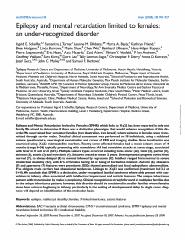Please use this identifier to cite or link to this item:
https://ahro.austin.org.au/austinjspui/handle/1/10515Full metadata record
| DC Field | Value | Language |
|---|---|---|
| dc.contributor.author | Scheffer, Ingrid E | en |
| dc.contributor.author | Turner, Samantha J | en |
| dc.contributor.author | Dibbens, Leanne M | en |
| dc.contributor.author | Bayly, Marta A | en |
| dc.contributor.author | Friend, Kathryn | en |
| dc.contributor.author | Hodgson, Bree | en |
| dc.contributor.author | Burrows, Linda | en |
| dc.contributor.author | Shaw, Marie | en |
| dc.contributor.author | Wei, Chen | en |
| dc.contributor.author | Ullmann, Reinhard | en |
| dc.contributor.author | Ropers, Hans-Hilger | en |
| dc.contributor.author | Szepetowski, Pierre | en |
| dc.contributor.author | Haan, Eric | en |
| dc.contributor.author | Mazarib, Aziz | en |
| dc.contributor.author | Afawi, Zaid | en |
| dc.contributor.author | Neufeld, Miriam Y | en |
| dc.contributor.author | Andrews, P Ian | en |
| dc.contributor.author | Wallace, Geoffrey | en |
| dc.contributor.author | Kivity, Sara | en |
| dc.contributor.author | Lev, Dorit | en |
| dc.contributor.author | Lerman-Sagie, Tally | en |
| dc.contributor.author | Derry, Christopher P | en |
| dc.contributor.author | Korczyn, Amos D | en |
| dc.contributor.author | Gecz, Jozef | en |
| dc.contributor.author | Mulley, John C | en |
| dc.contributor.author | Berkovic, Samuel F | en |
| dc.date.accessioned | 2015-05-15T23:59:01Z | |
| dc.date.available | 2015-05-15T23:59:01Z | |
| dc.date.issued | 2008-01-29 | en |
| dc.identifier.citation | Brain : A Journal of Neurology 2008; 131(Pt 4): 918-27 | en |
| dc.identifier.govdoc | 18234694 | en |
| dc.identifier.other | PUBMED | en |
| dc.identifier.uri | https://ahro.austin.org.au/austinjspui/handle/1/10515 | en |
| dc.description.abstract | Epilepsy and Mental Retardation limited to Females (EFMR) which links to Xq22 has been reported in only one family. We aimed to determine if there was a distinctive phenotype that would enhance recognition of this disorder. We ascertained four unrelated families (two Australian, two Israeli) where seizures in females were transmitted through carrier males. Detailed clinical assessment was performed on 58 individuals, using a validated seizure questionnaire, neurological examination and review of EEG and imaging studies. Gene localization was examined using Xq22 microsatellite markers. Twenty-seven affected females had a mean seizure onset of 14 months (range 6-36) typically presenting with convulsions. All had convulsive attacks at some stage, associated with fever in 17 out of 27 (63%). Multiple seizure types occurred including tonic-clonic (26), tonic (4), partial (11), absence (5), atonic (3) and myoclonic (4). Seizures ceased at mean 12 years. Developmental progress varied from normal (7), to always delayed (4) to normal followed by regression (12). Intellect ranged from normal to severe intellectual disability (ID), with 67% of females having ID or being of borderline intellect. Autistic (6), obsessive (9) and aggressive (7) features were prominent. EEGs showed generalized and focal epileptiform abnormalities. Five obligate male carriers had obsessional tendencies. Linkage to Xq22 was confirmed (maximum lod 3.5 at = 0). We conclude that EFMR is a distinctive, under-recognized familial syndrome where girls present with convulsions in infancy, often associated with intellectual impairment and autistic features. The unique inheritance pattern with transmission by males is perplexing. Clinical recognition is straightforward in multiplex families due to the unique inheritance pattern; however, this disorder should be considered in smaller families where females alone have seizures beginning in infancy, particularly in the setting of developmental delay. In single cases, diagnosis will depend on identification of the molecular basis. | en |
| dc.language.iso | en | en |
| dc.subject.other | Adolescent | en |
| dc.subject.other | Adult | en |
| dc.subject.other | Aged | en |
| dc.subject.other | Child | en |
| dc.subject.other | Child, Preschool | en |
| dc.subject.other | Chromosomes, Human, X.genetics | en |
| dc.subject.other | Developmental Disabilities.complications.genetics | en |
| dc.subject.other | Electroencephalography | en |
| dc.subject.other | Epilepsy.complications.genetics | en |
| dc.subject.other | Female | en |
| dc.subject.other | Genetic Diseases, X-Linked.genetics | en |
| dc.subject.other | Genetic Linkage | en |
| dc.subject.other | Heterozygote | en |
| dc.subject.other | Humans | en |
| dc.subject.other | Intellectual Disability.complications.genetics | en |
| dc.subject.other | Male | en |
| dc.subject.other | Mental Disorders.complications.genetics | en |
| dc.subject.other | Middle Aged | en |
| dc.subject.other | Pedigree | en |
| dc.subject.other | Phenotype | en |
| dc.title | Epilepsy and mental retardation limited to females: an under-recognized disorder. | en |
| dc.type | Journal Article | en |
| dc.identifier.journaltitle | Brain | en |
| dc.identifier.affiliation | Epilepsy Research Centre, Department of Medicine, University of Melbourne, Heidelberg Repatriation Hospital, Banksia Street, Heidelberg VIC 3081, Australia | en |
| dc.identifier.doi | 10.1093/brain/awm338 | en |
| dc.description.pages | 918-27 | en |
| dc.relation.url | https://pubmed.ncbi.nlm.nih.gov/18234694 | en |
| dc.type.austin | Journal Article | en |
| local.name.researcher | Berkovic, Samuel F | |
| item.fulltext | With Fulltext | - |
| item.grantfulltext | open | - |
| item.languageiso639-1 | en | - |
| item.openairecristype | http://purl.org/coar/resource_type/c_18cf | - |
| item.cerifentitytype | Publications | - |
| item.openairetype | Journal Article | - |
| crisitem.author.dept | Epilepsy Research Centre | - |
| crisitem.author.dept | Epilepsy Research Centre | - |
| crisitem.author.dept | Neurology | - |
| Appears in Collections: | Journal articles | |
Files in This Item:
| File | Description | Size | Format | |
|---|---|---|---|---|
| 18234694.pdf | 190.51 kB | Adobe PDF |  View/Open |
Page view(s)
76
checked on Apr 27, 2025
Download(s)
130
checked on Apr 27, 2025
Google ScholarTM
Check
Items in AHRO are protected by copyright, with all rights reserved, unless otherwise indicated.
